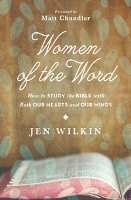Reviewed by Aimee Byrd
“The Bible does not want to be neatly packaged into three-hundred-and-sixty-five-day-increments” (75). No, no it doesn’t. But too often we think this is the only way to spending personal time in God’s Word. While we all know we are to be good Bereans (Acts 17:11), the sixty-six bound books of God’s living Word can be intimidating. And so Jen Wilkin begins her book disclosing the “mountain of biblical ignorance” she had after church hopping her whole life. Growing up visiting many different denominations, she wondered who had it right:
“Was there a rapture or not? Did God have to answer our prayers if we prayed a certain way? Did I need to be baptized again? How old is the earth? Were Old Testament believers saved differently than New Testament believers?” (16-17)
I can’t tell you how many times I have heard people try to dismiss these types of questions with a comment like, “I just love God and that is all that matters. I don’t want to get caught up in all that doctrinal stuff.” But Wilkin’s subtitle addresses this false dichotomy: “How to Study the Bible with Both Our Hearts and Our Minds.” And she tackles the importance of using both our minds and our hearts in the first chapter of her book. The Bible is about God, and as we learn about his person and his work, our joy and love for him deepens.
This is a very practical book, written to equip women to study God’s Word. Wilkin makes a case for Biblical literacy, and then presents a guide to help women study by way of alliteration. She teaches the five “P’s” of Bible study in five, short chapters. They are to study with Purpose, Perspective, Patience, Process, and Prayer. To be frank, I usually get annoyed with these approaches because I find them kind of condescending. But Jen Wilkin pulls it off quite well. And I say that because I don’t want those like me to let that keep them from reading or recommending Women of the Word.
Throughout the book, Wilkin uses good illustrations followed by practical applications to study God’s Word. I especially liked how she uses the analogy of the city of Rome in her chapter on studying with perspective. Since modern-day Rome was built on top of ancient Rome, there are some similarities with the way a homeowner in Rome needs to approach renovations to our perspective when we read Scripture. “Modern-day Christians inherit a faith that is built on the foundations of that which has come before. We, too, must occupy a modern space while maintaining an ancient perspective” (62). She explains how we need to play the role of an archeologist as we do some digging to learn the cultural and historical perspectives of the books we study in Scripture. And Wilkin follows with five practical questions to ask as a guide to get that proper perspective.
My favorite chapter is “Study with Patience.” Here the author offers a good critique of the contemporary approach to Scripture:
The preponderance of devotional material available to us bears evidence to our love for the neatly-wrapped package: a spiritual insight paired with a few verses and an application point or two. We approach our “time in the Word” like a drive-through at McDonalds: “I’ve only got a few minutes. Give me something quick and easy to fill me up.” (74)
Wilkin presses on the reader a long-term focus. While the study methods she offers are simple and basic enough to help a complete beginner with a sort of “How to Read the Bible 101,” it still takes work and investment. I love how she encourages the reader that feeling lost or confused in a passage is not a bad thing, but can actually be a sign that their understanding is being challenged. That’s how we grow! And sometimes the understanding doesn’t come that day, or that week, or even that year. But we trust God’s Word is living and active. We don’t always get the pretty applications tied up in a bow after our “quiet time with the Lord.” And so Wilkin challenges us, “Are you willing to invest ten years in waiting for understanding?” (81). What’s ten years compared to eternity?
Jen Wilkin’s method of studying Scripture is very helpful. While I am not typically going to follow her advice to type out each section I am studying, I see the value in it and how it may be helpful. I approached the book knowing it was more for an audience of beginners. But I was pleasantly surprised with a wonderful chapter for teachers at the end. That was a great addition with beneficial advice, encouragement, and warnings.
So if you are looking for an unintimidating, quick read to help you study God’s Word with more purpose for yourself or for someone who is having trouble with personal Bible study, or if you are interested in teaching a study and would like some guidance, this is the book for you.
Aimee Byrd is a wife and mother of three and the author of Housewife Theologian. She is also the “Residing Housewife Theologian” here at Books At a Glance, reviewing books of interest to women.
